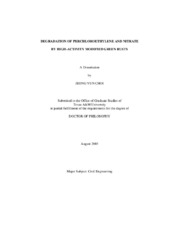| dc.description.abstract | Green rusts (GRs), a group of layered Fe(II)-Fe(III) hydroxide salts, have been observed to be effective reductants for degrading organic and inorganic contaminants under suboxic conditions. Furthermore, the addition of a transition metal to GRs can produce high-activity modified green rusts (HMGRs) that demonstrate higher degradation rates. Methods of modifying GRs to obtain high reactivity for degradation of PCE and nitrate were developed and reduction kinetics of PCE and nitrate by HMGRs were characterized in this study. First, the most promising HMGRs were developed through screening tests. GRs modified with Pt, Cu, Ag, or Pb were found to be effective in improving degradation rates of PCE. GR-F(Pt) and GR-F(Cu) were chosen because they showed high reactivity and produced non-chlorinated by-products. Pt and Cu showed the capability of improving reduction kinetics of nitrate by GRs. GR-F(Pt) and GR-F(Cu) were selected for further study. Second, degradation of PCE by GR-F(Cu) and GR-F(Pt) was characterized using a batch reactor system. The reaction kinetics of PCE degradation by GR-F(Cu) and GR-F(Pt) was strongly dependent on pH over the range of pH 7.5-11, with the fastest rate at pH 11. Increasing concentrations of Cu(II) over the range of 0 to 5 mM resulted in improving the reduction kinetics by a factor of more than 400, although the rate at 7.5 mM of Cu(II) was unexpectedly lower than that at 5 mM. Surface saturation behavior was observed in the rates of dechlorination of PCE by GR-F(Cu). Finally, nitrate reduction by GR-F(Cu) and GR-F(Pt) was further studied to determine the effects on degradation rates of pH, Cu(II) addition, and initial nitrate concentration. A reaction model with four sequential steps was proposed to describe the process of nitrate being reduced to ammonium and GR being oxidized to magnetite. The reaction rates of nitrate reduction by GR-F(Cu) and GR-F(Pt) was highest at pH 9. The reaction rates of GR-NO3 were improved by three orders of magnitude when Cu(II) was added in the range of 0 to 2.5 mM, while reaction rate decreased at concentrations above 2.5 mM. Saturation behavior was also observed in nitrate reduction by GR-F(Cu). | en |


